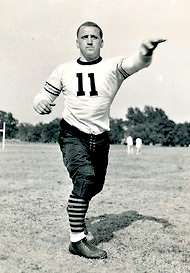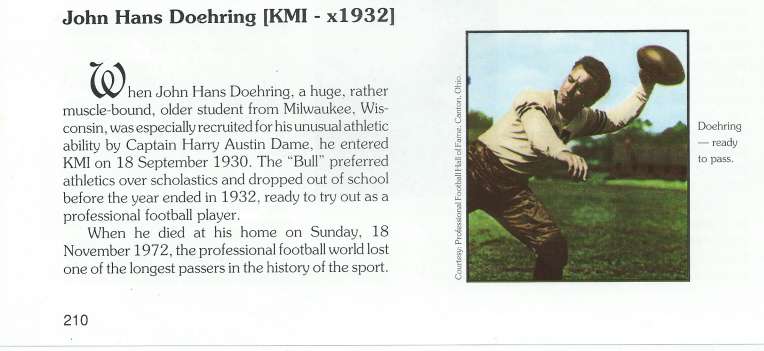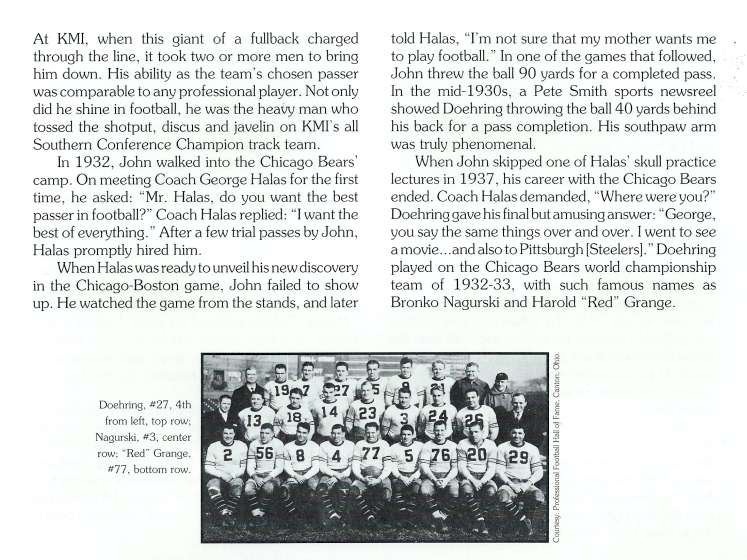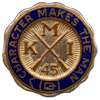  John Doehring, x'32 |
 |
 REFLECTIONS: A Portrait - Biography of the Kentucky Military Institute (1845 - 1971), pages 210-211 by James Darwin Stephens |
|
Forward
Passing, Behind the Back In
N.F.L.’s Early Days, John Doehring Was a Passing Sideshow in the
Chicago Bears’ Circus Act By
DAN DALY, Published: September 15, 2012 One
good reason is that newspaper coverage was sparse in the first few
decades; there simply wasn’t much reported beyond the games. So it is
hard to get a real feel for what pro football was like in that period —
and even harder to learn much about the players and personalities who
helped lift the league out of the primordial swamp. Good
luck, for instance, finding an article in any 1930s publication about
John Doehring, a Chicago Bears quarterback
known as Bull, who could fling the ball behind his back more than half
the length of the field. To fill this void, I spent two decades
researching and reading everything I could get my hands on about the
N.F.L.’s first half-century: long-ago-published books, newspaper
microfilm, archival material at the Pro Football Hall of Fame — and
interviewing scores of former players. What
I learned is that the first
50 years was an era of ideas. In 1929, the Orange Tornadoes thought it
would be cool to put letters on jerseys instead of numbers. In 1942,
Packers Coach Curly Lambeau kept his substitutes in the nice, warm
locker room, instead of on the sideline in frigid Green Bay. In 1950,
an aspiring N.F.L. owner proposed building an indoor stadium in
Houston, long before the Astrodome became a reality. The
decades since have been entertainingly anticlimactic. Once the American
Football League merged with the N.F.L. in 1970, everything changed.
When a sport ceases to have competition, it loses something — its
creative edge, maybe. And that breeds conservatism. The
league moves so slowly these days that it took about four decades to
fix the flawed overtime rules. If the A.F.L. were still around,
prodding the N.F.L. into being better, the correction would have come
much sooner. At
a time when passing attacks were still fairly primitive, Doehring’s
throws had an almost Sputnik-like quality about them. He wasn’t a great
player by any stretch, but he had one great talent — and the Bears
patriarch, George Halas, was smart enough to see it could be put to
use. Doehring could do more than just help the team win games; he could
be a sideshow, somebody who could entertain the fans with his
freakishly strong arm. He
was never more of a circus act than when the Bears barnstormed around
the country. During a workout in Los Angeles in January 1934, Doehring
uncorked a 70-yard pass to Bill Hewitt and “experienced the strange
sensation of hearing a wave of hand-clapping,” The Chicago Tribune
reported. Doehring was a product of
the Milwaukee sandlots who at 23 had decided to give pro football a
shot after failing his entrance exam to the University of Wisconsin. He
just showed up at a Bears practice in the middle of the 1932 season and
talked his way into a tryout. By the end of the week, he was suiting up
against the Portsmouth Spartans. “He
threw the ball so hard, nobody could catch it,” Ookie Miller, the
center on those Bears clubs, told me in the 1990s. “He gave Luke
Johnson a sore chest because it went right through his hands and hit
him in the chest.” Another
teammate, halfback Ray Nolting, said, “That son of a gun could throw a
ball 60 yards behind his back — accurately.” If
only Doehring had thrown a behind-the-back pass for a touchdown in an
actual N.F.L. game. Alas, it never happened. (That was not hard to
confirm because Doehring threw only seven touchdown passes in his
six-year career.) In
his 1947 book, “The Chicago Bears,” Howard
Roberts wrote that Doehring zipped a behind-the-back pass to Johnson in
a 1934 rout of Cincinnati but that Johnson dropped it in the end zone.
The only problem is George Strickler didn’t mention it in his article
for The Chicago Tribune — and Strickler didn’t get into the writer’s
wing of the Pro Football Hall of Fame by omitting such details. Doehring
definitely threw a behind-the-back touchdown pass on the barnstorming
trail, though. (What else was there to do in lopsided games?) The
Associated Press’s account of a January 1938 exhibition in New Orleans
ended with this line: “John Doehring, sensational southpaw passer for
the Bears, flipped one behind his back to Lester McDonald for 25 yards
and the pro team’s final touchdown as the Bears made a show of the
game.” Pro
football may never again be as fascinating as it was from the 1920s to
the ’60s. The N.F.L. is concerned with maintaining success now,
protecting everybody’s investment. In the salad days, when there was
less to lose, people were more willing to experiment — with lots of
things, just about anything. Doehring,
for instance, followed the lead of the Bears star Bronko Nagurski and
moonlighted as a pro wrestler, as did plenty of other N.F.L. players of
that era. He also played on a baseball team run by Happy Felsch, one of the
eight White Sox barred from the big leagues for throwing the 1919 World
Series. But
Doehring’s greatest gift was for wrapping his fingers around a ball and
letting it fly. In such moments, he could inspire awe. After
receiving a glimpse of Doehring’s behind-the-back act in 1937, Braven
Dyer of The Los Angeles Times wrote: “He attained this dexterity
without the aid of a college education. Had he received the benefits of
higher learning, he might be able to throw a curve which would come
back to him.” This
article is adapted from “The National Forgotten League: Entertaining
Stories and Observations from Pro Football’s First Fifty Years” by Dan
Daly, by permission of the University of Nebraska Press. It has always amazed me how little literary attention has been paid to professional football’s early days. Baseball historians have put the game under a microscope. There is probably a book out there that will tell you what Babe Ruth ate for breakfast on the day he swatted his 714th home run. The story of the N.F.L.’s formative years, on the other hand, is still largely untold.
Provided by Cappy
Gagnon |
